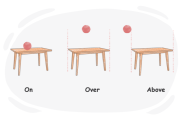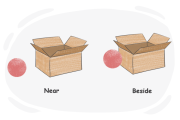Prepositions of Place
In this lesson, master prepositions of place to show where something is located. Clear explanations and practice exercises to help you learn.

What Are Prepositions of Place?
Prepositions of place are used to provide additional information about the location of a noun or pronoun in relation to other objects or places. These prepositions help to convey a clear picture of where something is and how it relates to its surroundings.
Prepositions of Place: Types
We can classify the prepositions of place into five groups, based on their meaning:
Prepositions used to show Direction '(up, down, in front of, behind)'
Prepositions used to show Location
These prepositions ('on', 'at', 'in') are the most common prepositions of place in English. Each of them is used to refer to the location or position of something or someone seen as a point.
At
'At' is used to talk about a specific place or location. It can be used to refer to:
addresses and landmarks
general location
events
public places that offer treatments or services
buildings such as institutions, companies, etc.
Take a look at some examples:
The university is at 98 Roosevelt Street.
address
They're at the mall right now.
general location, used when the exact location isn't important.
I was at a birthday party.
event
See you at the dentist's office.
public place
I had a meeting with Mary's teacher at school.
building
In
We use 'in' to talk about a specific area within a general space. This preposition is mostly used for:
geographical boundaries
large, open areas
a car
Take a look at some examples:
He works in New York.
within geographical borders
We went for a walk in the park.
a large, open space
I will wait for you in the car.
Warning
We can use both 'in' and 'at' to describe locations within a building. When we use 'in', we are indicating that the location is inside the enclosed space of the building. On the other hand, 'at' can also be used to indicate a location within a building, but it can also refer to the general area or vicinity of the place. For example:
See you in school.
inside the building
She's still at school.
On
'On' has two different meanings. When it is used to refer to location, it is often used for:
a floor in a building
showing that something is touching a flat surface
public transport
roads, streets, rivers, oceans, and lakes (names only, not exact addresses)
something that is physically attached or joined to something else
Take a look at some examples:
The boss's office is on the 7th floor.
Please hang the painting on the wall behind the sofa.
We enjoy going on a trip on the train.
They spent the weekend sailing on the rolling sea.
She was staring at the ring on her finger.
physically attached
Tip
We use 'at' to show a general location. Using the preposition 'on' shows a more specific location. Look at the examples:
She's at the beach.
She may be at a shop on the beach or in the water.
She's on the beach.
She is actually on the shore.
Prepositions used to show Position
These prepositions are used to show the position of something in a vertical line. We can arrange them from the highest position to the lowest position. Let us go through these prepositions one by one.
Above
Over
On
Under
Beneath
Below
Above
'Above' is used to show that something is on a higher position than another thing, without physical contact and often with some vertical distance. For example:
The birds were flying above the clouds.
The sun is above the horizon.


Over
'Over' is a preposition used to indicate that something is at a higher level than something else, or that something covers or touches something else. 'Over' often implies direct vertical alignment. For example:
Mom kept the umbrella over our heads.
Her mother put a blanket over her.
On
As we mentioned before, 'on' has two meanings. When 'on' is used as a vertical proposition, it shows physical contact with a horizontal surface.
The candles are on the table.
He put the glasses on the kitchen counter.
Under
'Under' is a preposition that refers to a position lower than something. For example:
There are no monsters under the bed, Johnny!
The cat is hiding under the table.


Beneath
'Beneath' is often used to indicate that something is located directly underneath another object or surface. It can imply being covered or hidden. For example:
The shop is right beneath the apartment.
The treasure was buried beneath the sand.
Below
'Below' is typically used to indicate that something is located at a lower level than another object or surface and is not touching it. For example:
Just below the surface of the water, the crocodile hid.
The plane flew below the clouds.
In the list below, you can see some other examples of prepositions used to show position:
Underneath
On top of
Prepositions used to show Distance
These prepositions are also called prepositions of proximity. They show how close someone or something is to another person or thing.


Near
'Near' is used to show a short distance from something or someone else. For example:
The parking lot is near the shopping center.
Don't go near the edge.
If you swim near the bottom, you can see the coral reefs.
Beside, Next to, and By
These three prepositions are used to show that someone or something is close to another thing or person. They are similar in meaning. However, there is a subtle difference between them. 'Beside' shows that there is no space between two things. Also, it is not common to use 'beside' with things that don't have sides.
The umbrella is beside that chair.
There is no space between the chair and the umbrella.
'Next to' shows that there is nothing between the two objects or persons, although there might be space.
The umbrella is next to that chair.
There is nothing between the umbrella and the chair.
'By' means close, but not as close as 'beside'.
They're standing by the car.
Tip
Remember that 'beside', 'next to', 'by', and 'near', are all prepositions of proximity; but while 'near' is more general in indicating a short distance, the others show that something is placed in a horizontal position relative to another thing.
Beyond
'Beyond' is a preposition used to indicate a location or position that is farther away or on the other side of sosmething. For example:
You can find the castle beyond the bridge.
On the list below you can see some other examples of distance-related prepositions:
Prepositions used to show Direction
While 'in front of' and 'behind' are used to show a horizontal direction in front and back of something, 'up' and 'down' are used to show a vertical direction, on a higher or lower level.
Up
As mentioned before, we use 'up' to show that something is located at a higher position. Look at the example below:
Their cabin is up the mountain.
The cat is up the tree.


Down
We use 'down' to show that something is located at a lower position. Look at the example:
The lake is just down the hill.
Their house is down the valley.
In front of
This preposition shows a position ahead of another thing. It also shows the position facing something or someone. For example:
The car was parked in front of my house.
I get so nervous in front of the camera.


Behind
'Behind' is the opposite of 'in front of'. It refers to the position at the back of something.
The sun hid behind the clouds.
The dog was standing behind the car.
In the list below, you can see some other examples of prepositions used to show direction:
Prepositions used for Enclosed Area
By using this group of prepositions, we can show the position of something or someone in relation to an enclosed area.
In
'In' is used to show the position inside an enclosed (or semi-enclosed) area, like a room, building, container, etc. Look at the example:
There's some tea left in my mug.
The baby is sleeping in her room.
Outside
'Outside' is used to show the position external to an enclosed (or semi-enclosed) area. Look at the example:
The fans were waiting outside the cinema.
I'm waiting outside the office building.
In the list below, you can see some other examples of prepositions used for enclosed areas:
Within
Inside
Review
We use prepositions of place to show the location or position of someone or something. Based on their meaning, we can categorize these prepositions into 5 groups:
Prepositions used to show Location (on, at, in)
Prepositions used to show Horizontal Position (above, over, below, under, on, beneath)
Prepositions used to show Distance (near, beside, next to, by, beyond)
Prepositions used to show Direction (up, down, in front of, behind)
Prepositions used for Enclosed Area (in, within, inside, outside)
Quiz:
Which sentence uses the correct preposition of place?
The painting hangs under the wall.
The children are playing on the park.
She left her phone in the car.
We met over the restaurant.
Match each sentence to the correct preposition group.
Which of the following sentences correctly uses a preposition of place to show direction?
The kids are playing in the backyard.
He walked behind the stage to get ready.
The picture hangs over the fireplace.
She lives near the train station.
Match each incomplete sentence with the correct ending.
Fill in the blanks with the correct prepositions of place.
The books are lying
the table. (on/in/at)
The mountains are just
the river. (over/beyond/inside)
Please park your car
the building. (in/above/in front of)
The child is sitting
his mother. (beside/at/outside)
The bank is
the grocery store. (down/next to/up)
